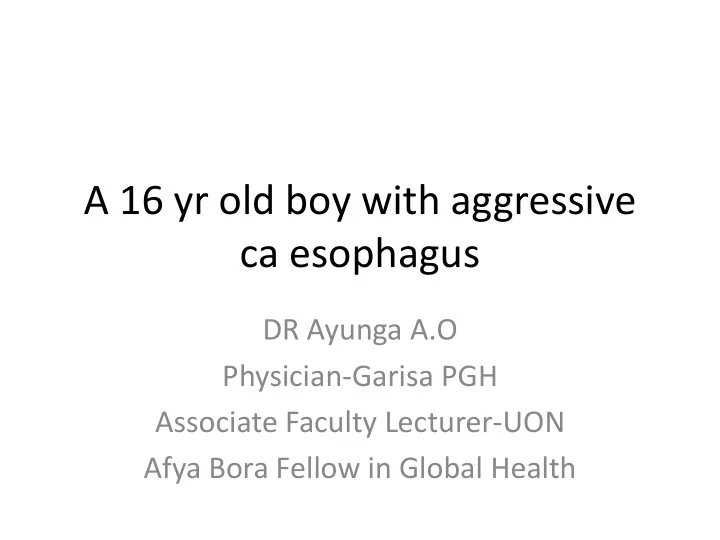

A 16 yr old boy with aggressive ca esophagus DR Ayunga A.O Physician-Garisa PGH Associate Faculty Lecturer-UON Afya Bora Fellow in Global Health
Cancer of esophagus in a 16yr old • Y.N 16 yr old boy • unwell for the past 3 yrs with on and off dyspepsia and hurtburn • He was being managed for peptic ulcer disease. • Pt presented to our hospital on the 28/7/12 with c/o - of retrosternal and epigastric pain -postprandial vomiting, -hematemesis, - progressive dysphagia. • O/E patient was sick looking,wasted with epigastric tenderness with no palpable masses or organomegally
Investigations • Investigations done: 1.barium swallow 1yr back that demonstrated a distal 1/3 oesophageal stricture. 2.FHG which was normal. 3.h.pylori test – negative.
• Patient was referred to KNH for an OGD ,biopsy and CT scan which were done on 25/8/12 and showed : • OGD: stricture at 30cm blocking lumen. • Biopsy: necrotic tumor disposed in nests of very pleomorphic squamous cells with a diagnosis of poorly differentiated SCC. • CT scan: malignant stricture of esophagus at T5-T10 with proximal dilatation,small subcentimetre mediastinal nodes.
• Pt advised to have surgery but could not afford at the time and presented again on 17/10/12 with vomiting,inability to swallow and hotness of body. • Patient was put on intravenous fluids and referred to Nyeri for surgical management-ivor lewis esophagectomy was done on 6/11/12 . • Tumour was resected with 3cm free margin and was transfused 6 pints of blood. • Pt admitted in ICU post-op and developed ARF but regained normal RF after 3 days of Rx. • Discharged while he was able to feed and with normal bowel movements.
• Patient was brought back to Garissa PGH 30 days postop for palliative management. • He was was markedly wasted with bilateral lower limb pitting edema upto midleg and had a right chest tube draining purulent fluid. • Patient developed left sided empyema thoracis 2 nd day post admission which was drained by a chest tube. • right chest tube was removed but 6 th post admission day patient developed a right pneumothorax and a right chest tube was reinserted.
Further tests after readmission • Investigations done: • FHG: WBC 12.1 with granulocytes 88%,HB 13.9,MCV and MCH normal,PLT 207. • Electrolytes: k 3.59,Na 131.4,Cl 104.1. • Creatinine:239.52. • LFT:AST 41.75,ALP 346.4,GGT 181.05,Albumin 1.71,total protein 5.49,Direct bilirubin 6.56,total bilirubin 28.7. • Pleural fluid M/C/S: gram stain heavy growth of s.aureus with many intracellular G-ve diplococcic sensitive to linezolid and resistant to PenG,oxacillin,azithromycin and sporfloxacin.
• Patient was put on high protein diet,sc heparin 5000iu BD,IV flagyl and IV ceftriaxone. • patient was doing well in the ward with mild respiratory distress. • On 17/12/12 patient developed severe respiratory distress with a left chest tube insitu,Xray done showed bilateral pneumothorax,patient was put on oxygen via nasal prongs(relatives declined via mask). • family declined chest tube reinsertion on the right side. • On th 18/12/12 morning patient was certified dead.
Discussion • Esophageal cancer usually develops in persons between 50 and 70 years of age. • M:F 3:1. • There are two histologic types: squamous cell carcinoma and adenocarcinoma. • Chronic alcohol and tobacco use are strongly associated with an increased risk of squamous cell carcinoma. • Other risks are Tylosis, achalasia, caustic-induced esophageal stricture, and other head and neck cancers.
• SCC has a high incidence in certain regions of China and Southeast Asia. • 50% of all cases occur in the distal third of the esophagus. • Adenocarcinoma is more common in whites. • The majority of adenocarcinomas develop as a complication of Barrett's metaplasia due to chronic gastroesophageal reflux. • Most adenocarcinomas arise in the distal third of the esophagus
Symptoms • Most pts with esophageal cancer present with advanced, incurable disease. • Over 90% have solid food dysphagia, which progresses over weeks to months. • Odynophagia is sometimes present. • Significant weight loss is common. • Local tumor extension into the tracheobronchial tree may result in a TOF, characterized by coughing on swallowing or pneumonia.
• Chest or back pain suggests mediastinal extension. • Recurrent laryngeal involvement may produce hoarseness. • Physical examination is often unrevealing. • The presence of supraclavicular or cervical lymphadenopathy or of hepatomegaly implies metastatic disease.
investigations • Lab-Non specific • Anaemia of chronic disease • Hypoalbuminemia due to malnutrion • CXR-may show adenopathy, a widened mediastinum, pulmonary or bony metastases, or signs of TOF. • Barium esophagiogram fisrt study followed by OGD with biopsy
DDX • Achalasia • Peptic stricture • Adenocarcinoma of the gastric cardia with esophageal extension • Benign tumours
Staging • Done to guide therapy • CT scan of chest and liver to exclude metastases,lympadenopathy or tumour extension • Two most important predictors of poor survival are lymph node involvement and adjacent mediastinal spread.
Treatment • Depends on the stage • IIIB- palliation-Combination radiation and chemotherapy
Recommend
More recommend